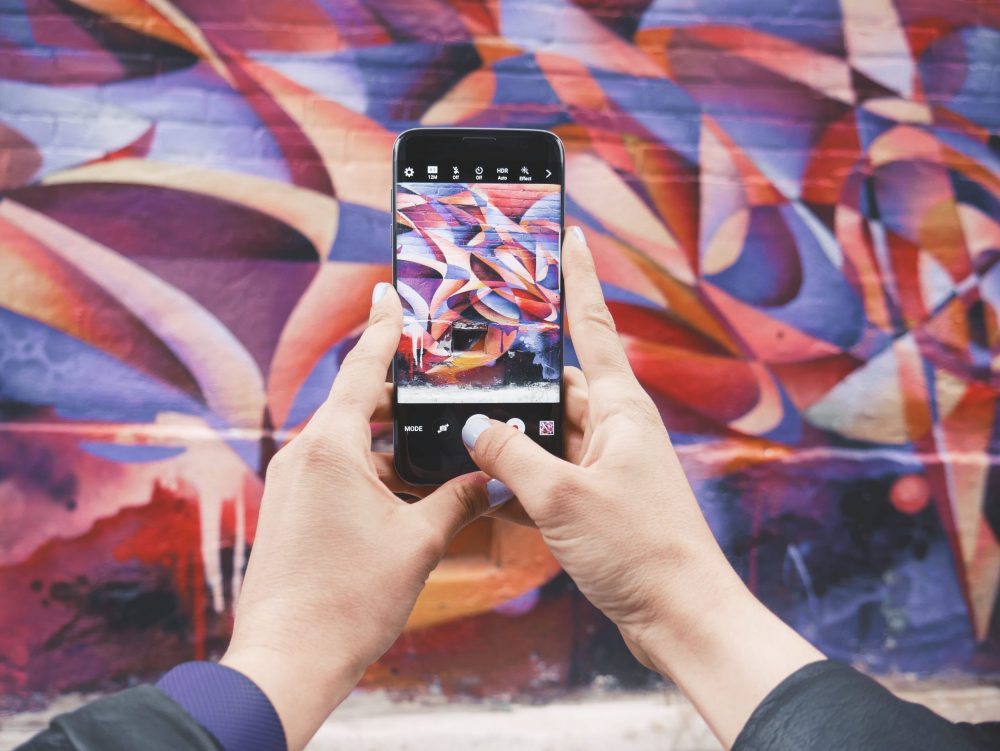Here’s the 411 on social media marketing, from LinkedIn to TikTok.
Here, you’ll find:
- A breakdown of the main paid social platforms
- How these social platforms compare
- Best practices for audience targeting
- Steps to building a successful paid social campaign
Whether you’re a constant Twitter feed refresher or barely remember to check your LinkedIn messages, social media’s influence on current culture can’t be denied.
As a society, we’re more connected than ever through the internet. For better or worse, the share of U.S. adults who now report that they go online “almost constantly” has risen to 31%, up from 21% in 2015, according to the Pew Research Center.
Social media platforms help us keep up with friends and family, stay informed about current events, foster professional connections, and offer glimpses into our real lives — filtered or not.
So it’s no surprise that paid social, also known as social media marketing, can be a huge boost for digital marketing programs — if you know how to do it right. For tips, best practices, expert advice, and more, read on.
What is paid social?
When we say “paid social,” we’re talking about ad campaigns via sponsored or promoted posts on social media platforms. These posts are a form of advertising that appear in a social media feed, timeline, or on a page.
Brands often use paid social to expand their reach and target their audience in a way that’s both hyper-focused and seamless.
Since most audience types already use at least one social media app, paid social posts can be a highly effective way to meet your ideal personas where they already are.
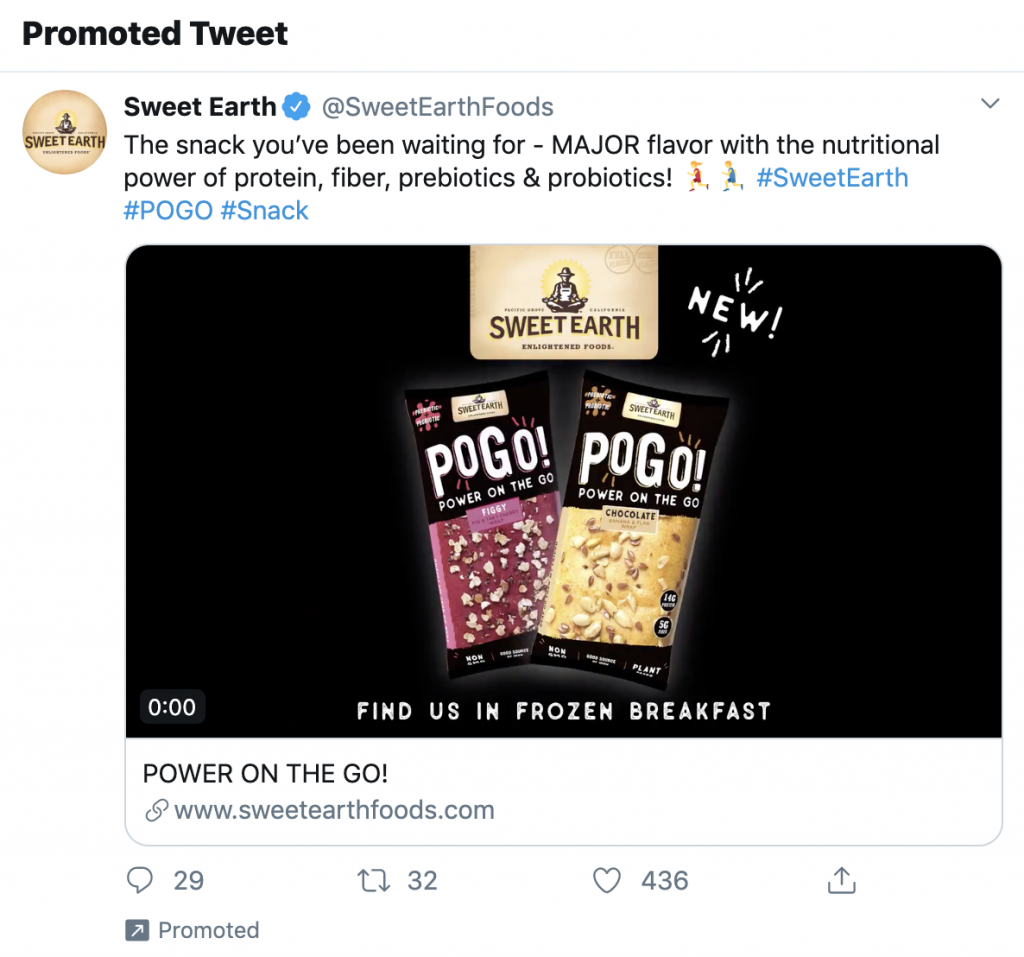
A paid social ad on Twitter (Image: Twitter)
The main players in paid social media marketing
The paid social platforms you choose to advertise on will depend on a few main factors: your product or service, the type of ad, and your audience.
While the list isn’t stagnant or set in stone, the main players in this space include:
- Facebook (aka Meta)
- Instagram (owned by Facebook)
- YouTube (owned by Google)
- TikTok
As with many other parts of creating a digital marketing strategy, knowing your target audience is key.
If you don’t already have your ideal client persona mapped out, start with creating 1-3 profiles using resources like market research and the demographics of your current customers.
For a paid social ad campaign, you also want to know which platforms your audience gravitates toward.
Generally, professionals favor LinkedIn. Gen X and Boomers tend to spend more time on Facebook than others. Pinterest is mostly visited by women. Instagram, YouTube, and Twitter all tend to skew more Millennial, while basically all generations (particularly Gen Z) use TikTok.
Perhaps your audience overlaps multiple generations or other demographics. If so, you can always begin with the more affordable platforms, conduct a few A/B ad tests, see how your audience reacts, and iterate accordingly.
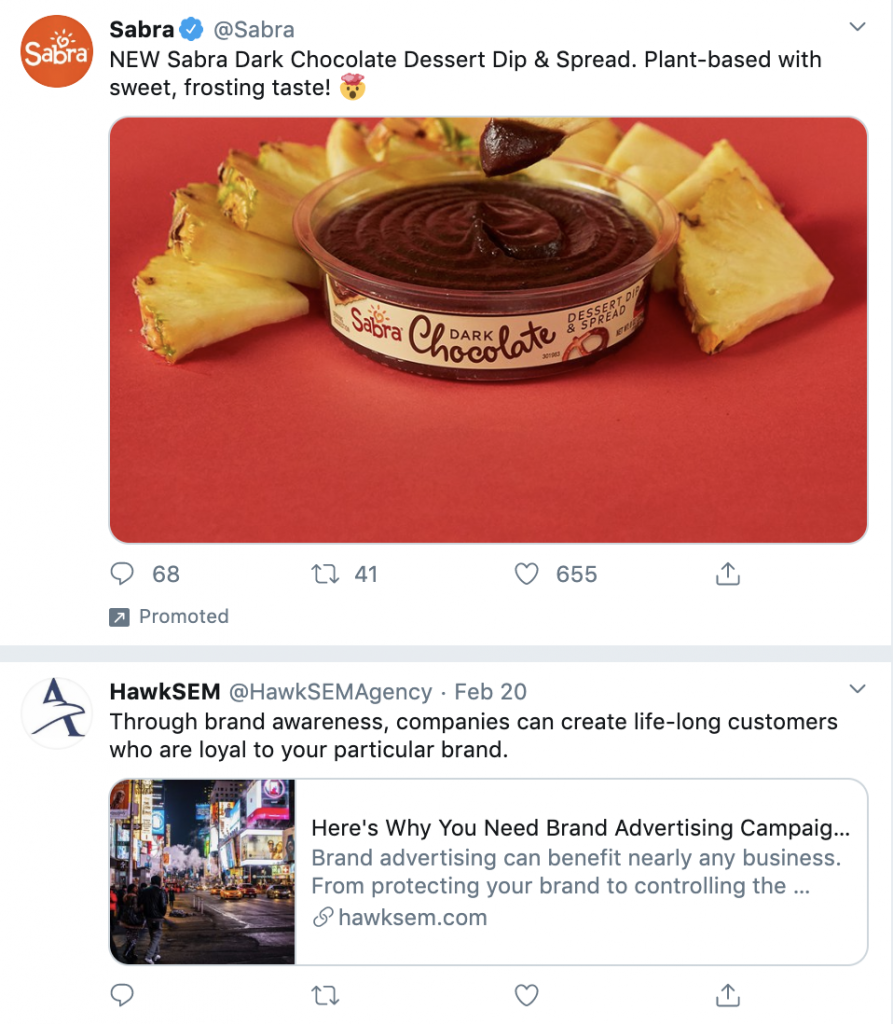
A sponsored post above an organic post on HawkSEM’s Twitter feed (Image: Twitter)
How is paid social different from organic social media?
One benefit of paid social ads for the brands leveraging them is how seamlessly they fit into a user’s existing social feeds.
These feeds are mostly populated with what’s called organic posts, which are free posts published by people you follow and brands whose pages you like or subscribe to.
Basically, organic content is what you post on your business or personal page, whether directly or through a scheduling platform like Hootsuite.
This content is seen by your followers and subscribers, though the exact percentage of followers who see this content varies by platform. These posts can also be shared by other individuals and spread further than just your following.
With sponsored content (which can be a form of paid social), you’re paying the advertiser (the social media platform, in this case) to put your post or ad in front of people beyond your current following. You choose the audience you want and the platform places the ads accordingly, per the parameters you set.
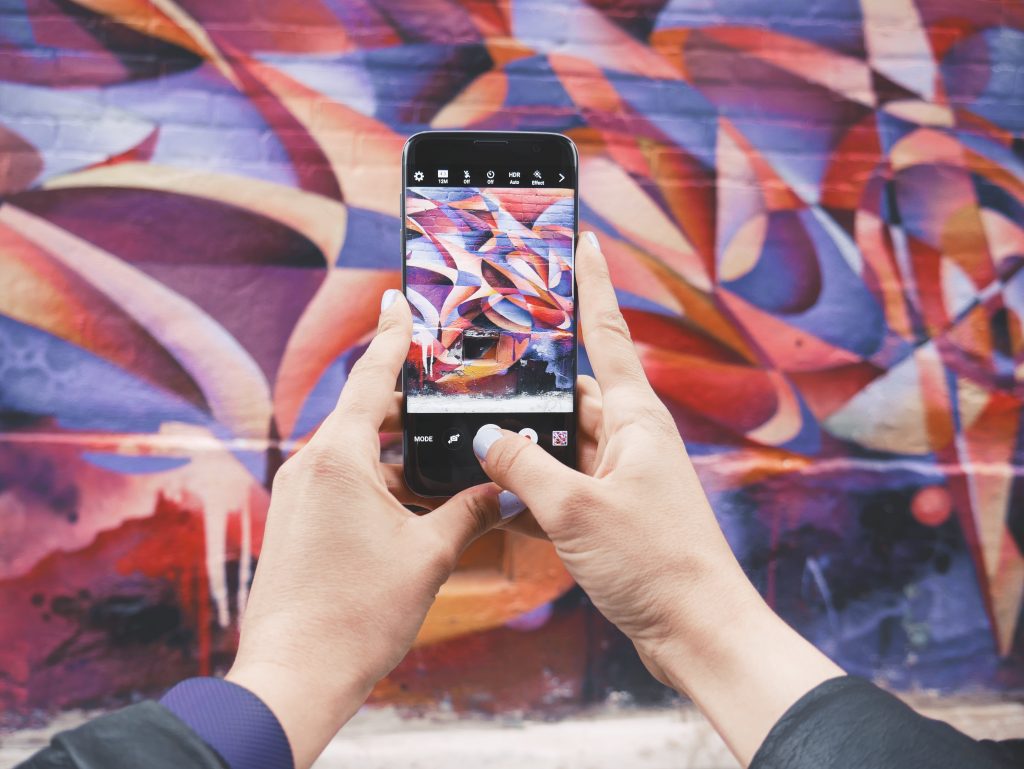
After you’ve determined the social media platform you’ll leverage for your campaign, you can start the work of actually building it. (Image: Unsplash)
Which paid social platforms should my company leverage?
As mentioned above, the social platform your company opts to advertise on will depend on your audience.
It’s good to have an understanding of what people use each platform for (we’ll get into that next).
Once you understand your demo (age, gender, etc.), check out the breakdown of their profile or subscriber averages per platform. Sprout Social has data that breaks down demographics by platform.
After deciding on the app, you’ve still got to determine which ad type you want to go with. Luckily, platforms like Facebook have ad managers that make it easier to decide which ad is right for you.
What are the paid social ad format options?
The ad types you can choose from will depend on the platform. The most common social media ad types include:
- Text ads
- Video ads
- Multi-image carousel ads
- Animated GIFs
- Image ads
- Product ads
- Collection ads
- Interactive ads
- Lead form ads
Tips for creating a successful paid social campaign
After you’ve determined the social media platform you’ll leverage for your campaign, you can start the work of actually building it. The must-haves for a good social campaign include:
- Determine your goals: There are a lot of options for the type of campaign you can run. Begin with deciding what you want from these efforts, whether it’s purchases, profile follows, subscribers, or something else.
- Keep user intent in mind: What is the user’s purpose on these social channels? Keep this in mind when choosing the audience you want to target — and what you want from them.
- Content is the key: No surprise here: The content of your paid social ad is the most important factor in its success. Make sure the imagery is high-quality, the copy speaks directly to your target audience, and it links to a consistent landing page with a clear call to action (CTA).
Pro tip: Know the parameters of the social media platform you use. Some are more strict than others when it comes to image or video quality, for example. Different ads may require varying specs, text lengths, video length caps, and more. Check out the platform’s website to learn more about each and find the one that best fits your campaign creative.
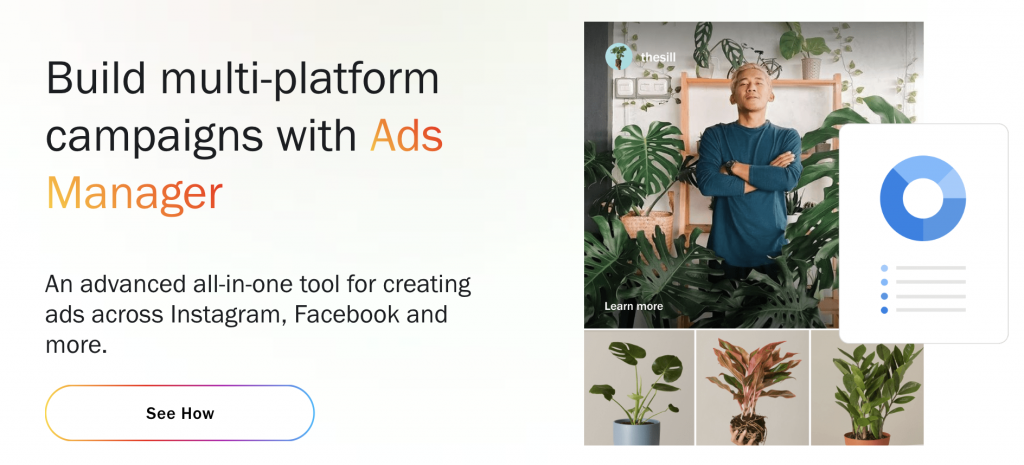
The powerful targeting capability is one of the biggest benefits of leveraging paid social as part of your digital marketing strategy. (Image: Instagram)
What are the latest social media marketing stats ?
Social media stats change as frequently as the platforms themselves. Here’s a handful of recent paid social facts and figures.
- Facebook is the most-used platform by marketers worldwide (93%).
- Responses to TV ads are higher in terms of both engagement (+40%) and memorability (+28%) when Twitter is included in the experience.
- Instagram crossed the 2 billion user mark In 2022.
- 40% of B2B marketers say LinkedIn is the most effective channel for driving high-quality leads.
- More than 50% of marketers plan on increasing their investments in Facebook, YouTube, and TikTok in 2022.
- 39% of Gen Z consumers say that their purchasing decisions are influenced directly by what they see on TikTok.
- Social media recently bested paid search as an advertising channel, growing 25% year over year and exceeding $137 billion (vs. paid search’s $135 billion).
What are the benefits of paid social campaigns?
The powerful targeting capability is one of the biggest benefits of leveraging paid social as part of your digital marketing strategy.
You can reach people based on their interests, hobbies, past internet usage (cookies), demographics, locations, and more. You can also target those in different stages of the buying cycle.
Another paid social benefit is the robust analytics these platforms offer. Not only can you see who clicks your ad, but you’re also often privy to metrics like impressions, likes, shares, and other related, relevant actions.
Some of the more overlooked benefits, according to Sprout Social, include:
- Uncovering industry trends in real-time
- Comprehensive competitive analysis
- Improved customer service
- Humanizing your brand
- Access to user-generated content (UGC) related to your brand
HubSpot reports that paid social campaigns are also great for:
- Increasing brand awareness
- Generating leads
- Boosting conversions
- Fostering customer relationships
- Inspiring brand loyalty
While awareness may be seen as easier to achieve but less valuable than these other benefits, it’s the first step to turning a person into a prospect.
Pro tip: While most platforms have campaign tracking capabilities, it’s a good idea to independently track performance as well (you can use your host site’s tracking or a program like Google Tag Manager). This ensures your tracking is accurate and offers a true set of data once your program is fully ramped up.
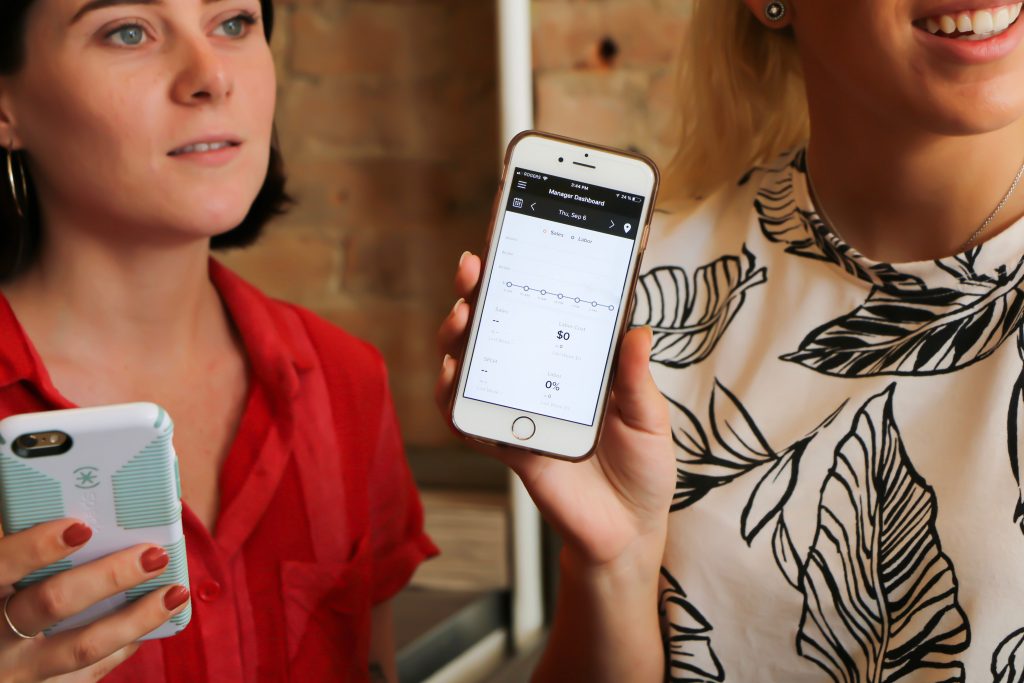
There’s no one-size-fits-all trick that’ll apply to ads across all social platforms. There are, however, best practices that do. (Image: Unsplash)
Audience segmentation options
Your options for audience segmentation will vary by platform. Let’s break it down.
LinkedIn – segment by:
- Job experience & skills
- Education & degrees
- Age & gender
- Company industry & size
- Interests
- Location & language
- Job function, title & seniority
- Years of experience
Facebook – segment by:
- Core audience
- Customer audience
- Lookalike audience
- Location
- Demographics
- Connections
- Interests
- Behavior
YouTube – segment by:
- In-market audiences (interest or topic based)
- Affinity audiences (interest or topic based)
Twitter – segment by:
- Age or gender
- Username
- Interest (including TV targeting)
- Conversation
- Event
- Tailored (from your website visitor and/or CRM data)
Instagram – segment by:
- Location
- Interests
- Demographics
- Behaviors
- Lookalikes
- Automated
- Custom (remarketing)
Pinterest – segment by:
- Customer list
- Previous site visitors
- Previous pin engagements
- Actalikes
- Third-party data (U.S. only)
TikTok – segment by:
- Lookalike
- Custom
- Gender
- Age
- Location
- Language
- Interests
- Behaviors
- Device
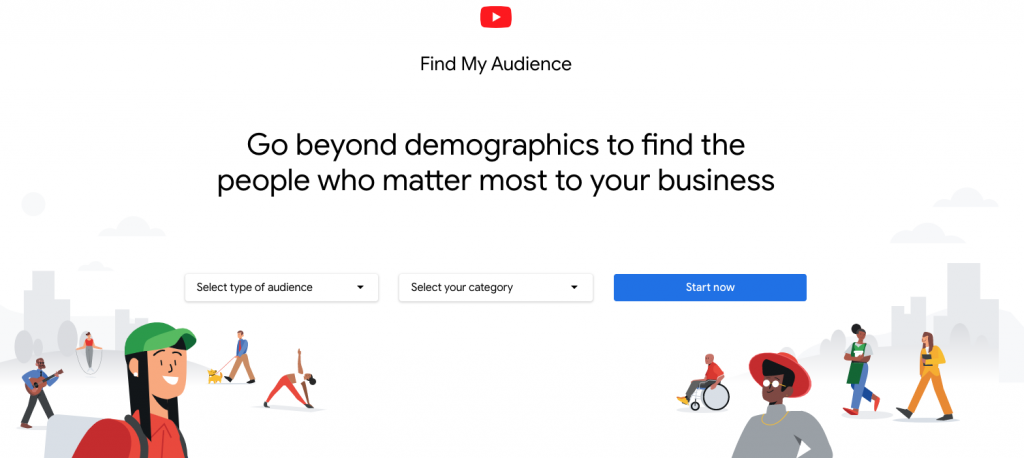
YouTube’s Find My Audience tool gives you a selection of categories to target by interest or industry. (Image: Google)
Success secrets for each social media platform
Again, there’s no one-size-fits-all trick that’ll apply to ads across all social platforms. There are, however, best practices that do. These include:
- Prioritizing your campaign’s creative components (copy and imagery/graphics)
- Copy that is concise and easy to understand
- A message that’s appropriate for the audience you’re targeting
- The platform that’s appropriate for the audience you’re targeting
- A clear CTA
On the back end, you also want to double-check that the destination link (the URL the ad links to) is correct and working.
You also want to set up good tracking to ensure you’ve got accurate analytics from the beginning — most platforms have an in-house pixel you can place on the ad.
Pro tip: It can be tempting to hop on the bandwagon of every emerging social media app. While it’s good to snag your company’s username on new platforms, it’s often better to allocate your budget to more established ones. Keep an eye on what’s trending by subscribing to social media-focused newsletters to see what might be worth your ad dollars down the line.

LinkedIn’s ads let you target different funnel stages as well as demographics. (Image: LinkedIn)
Should my company explore influencer marketing?
Influencer marketing is when a company partners with an influential person or group (often for a certain industry) for a campaign to endorse, advocate, or amplify the brand.
These days, nearly all industries have influencers in their space — even the ones you may not think of as influencer-heavy, such as healthcare.
If you’re not sure whether influencer marketing is right for you, conduct some research to see if you can find influencers in your niche. It’s also wise to see if your competitors have leveraged them in the past.
Once you’ve decided to test out influencer marketing, set yourself up for success by:
- Mapping out your campaign plan and goals
- Identifying a few potential influencers
- Determining the level of influencer you want (it ranges from nano to A-list celeb and will depend on your budget, obviously)
- Nailing down the type of influencer content you’re looking for
How to test paid social ads
Just like you (hopefully) would with any other digital marketing campaign, testing and iterating should be baked into your process. Consider testing out varieties of copy, visuals, and mediums, such as an image vs. a short video.
It’s worth noting that some industries may naturally perform better than others, and some platforms are harder than others to achieve success. But there are things you can do to set yourself up for maximum return on ad spend (ROAS).
Let’s talk about visuals. You don’t have to blow through your budget on movie-quality vids, but you may have to get creative.
Sometimes a stock photo — possibly overlaid in your brand’s colors — can be the perfect complement to get your point across.
And, again, it’s about knowing the intent of each platform. LinkedIn may not be the place for a goofy video, and trying to get template or whitepaper downloads on Instagram might be a bust.
Lastly, if your business has a creative team in charge of ad design, make sure they have the proper specs for each platform you’re using. If you’re running a video ad, you should know how long it can be before it cuts off.
Budgeting and goal-setting for paid social ads
Remember what we said before about determining your goals?
You should have goals figured out before you create your campaign. Having the goals you want — whether that’s a certain number of purchases per month, a certain ROAS percentage, or something else — makes the process go much smoother.
Some platforms, such as Facebook, optimize your campaign to your goal. Awareness campaigns, for example, are more broad and thus harder to track, so knowing that from the beginning helps you create realistic goals.
The bigger the platform and audience, the more homed in on your goal you’ll want to be. You don’t need to worry about being as targeted on a comparatively smaller platform like LinkedIn as you do on a larger, more globally used platform like Facebook.
When it comes to goal setting (also called the campaign’s objective), start small. We don’t suggest running a giant $2,000 a day campaign straight out of the gate.
You can also experiment with targeting different locations instead of trying to blanket the entire country — your budget will go much further this way.
Ready to take your paid social campaigns to the next level? Check out our list of tactical tips and tricks you can put into action today.
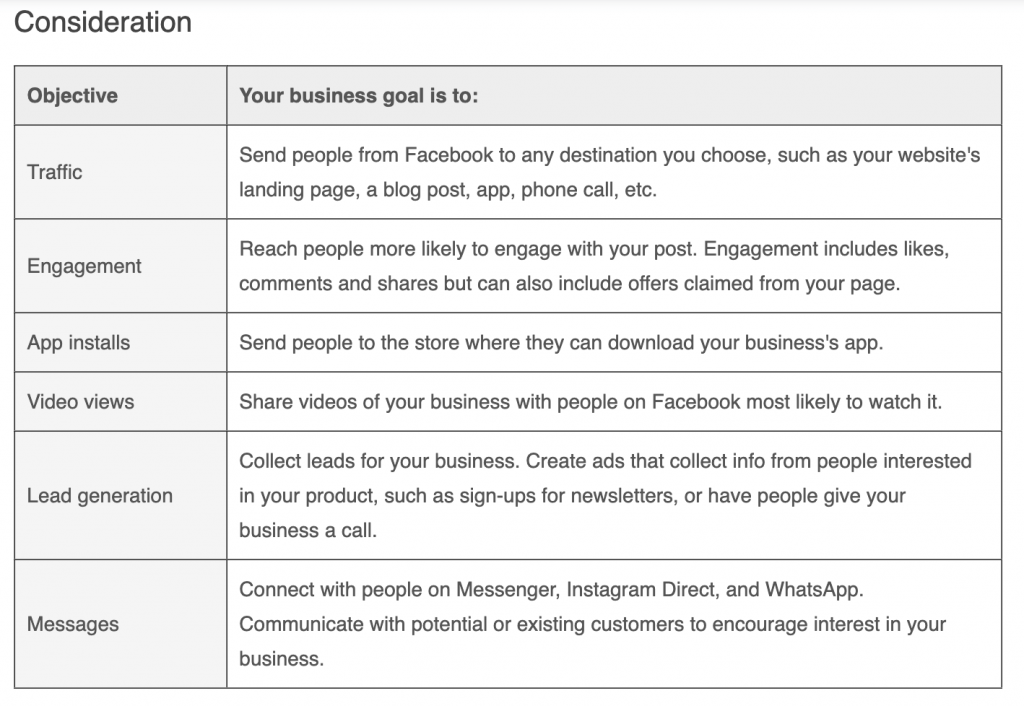
Facebook’s ad objective breakdown for the Consideration stage. (Image: Facebook)
Depending on your product or service, the platform may be able to guide you towards the ad type that’s best for your goal. Try out their recommendation, then you can better optimize from there as the data comes in.
When you’re building your campaign, most platforms have an “audience reached” metric on the back end that will tell you the approximate audience size for your chosen parameters, as well as what you can reach with your chosen budget.
The takeaway
With the popularity of social media growing exponentially by the year, it’s definitely worth exploring as part of any robust digital marketing program.
Those who find success with paid social do so by having a solid strategy laid out and an idea of the right platforms for their brand before they start building.
By recognizing that content is key, remembering each platform has different requirements, understanding your audience, targeting properly, and budgeting appropriately, you’ll find that social platforms can be a fun and creative way to connect with and grow your audience.
This article has been updated and was originally published in February 2020.
